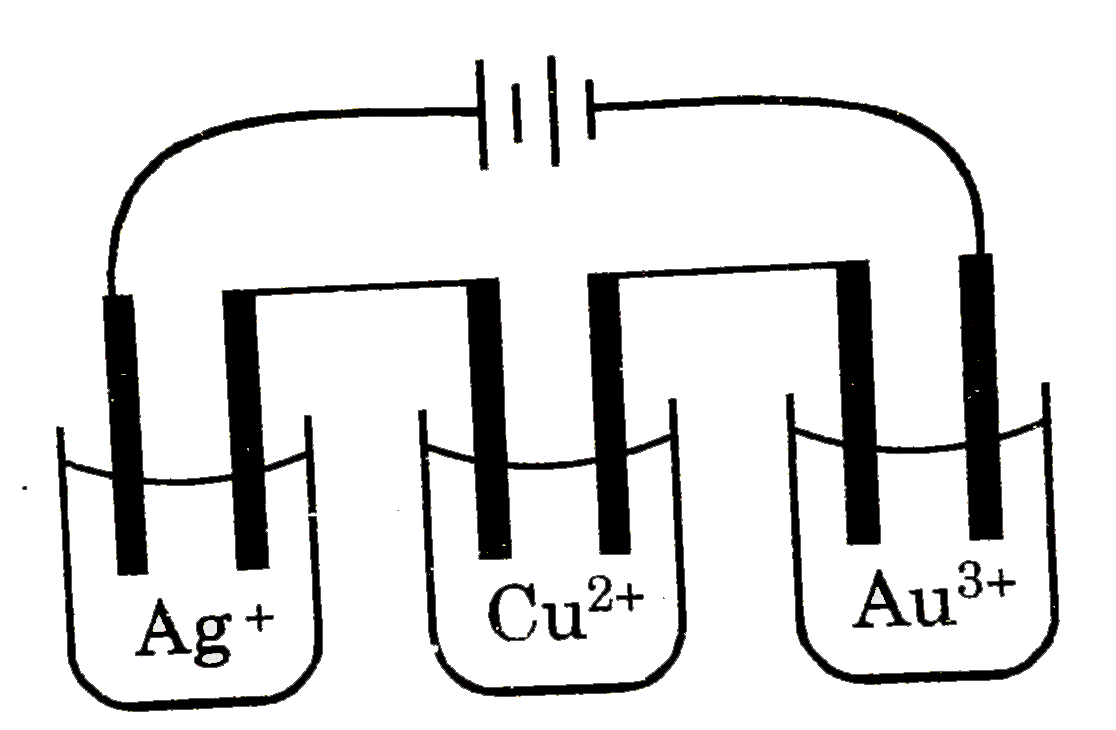1.0 M aqueous solutions of PNO3,Q(NO3)2 and R(NO3)3 are electrolyzed in the apparatus shown, so the same amount of electricity passes through each solution. If 0.10 moles of solid Q are formed how many moles of P and R are formed?

0.10 moles P, 0.10 moles R
0.05 moles P 0.075 moles R
0.20 moles P, 0.067 moles R
0.05 moles P, 0.15 moles R
The correct Answer is:C
Q2++2e−→Q
2F charge will produces = 1 mole of Q
1 mole of Q = 2F charge
0.1 mole of Q = 0.2 F of charge
P++e−→P
1F charge = 1 mole of P
0.2 F charge = 0.2 mole of P
R3++3e−→R
3F of charge = 1 mole of R
0.2 F of charge =13×0.2=0.067 mole of R.
Similar Questions
Knowledge Check
1.0 M aqueous solutions of AgNO3,Cu(NO3)2 and Au(NO3)3 are electrolyzed in the apparatus shown, so that same amount of electricity passes through each solutions. If 0.10 mols of solid Cu are formed how many "mole"s of Ag and Au are formed?
 A0.10 "mole"s Ag, 0.10 "mole"s AuB0.05 "mole"s Ag, 0.075 "mole"s AuC0.05 "mole"s Ag, 0.15 "mole"s AuD0.10 "mole"s Ag, 0.067 "mole"s Au
A0.10 "mole"s Ag, 0.10 "mole"s AuB0.05 "mole"s Ag, 0.075 "mole"s AuC0.05 "mole"s Ag, 0.15 "mole"s AuD0.10 "mole"s Ag, 0.067 "mole"s AuHow many moles of Pt may be deposited on the cathode when 0.80F of electricity is passed through 1.0M solution of Pt4+?
A0.1 molB0.2 molC0.4 molD0.6 molHow many moles of platinum will be deposited on the cathode when 0.60 F of electricity is passed through a 1.0 M solution of Pt4+ ?
A0.60 molB0.15 molC0.30 molD0.45 mol
A solution of Ni(NO3)2 is electrolysed between platinum electrodes using 0.1 Faraday electricity. How many mole of Ni will be deposited at the cathode?
View SolutionHow many moles of NO2 are produced when 1 mole of B reacts with HNO3 ?
View SolutionHow many moles of Pr may be deposited on the cathode when 0.80F of electricity is passed through 1.0M solution of Pt4+?
View SolutionAn aqueous solution containing one mole per litre of each Cu(NO3)2,AgNO3,Hg(NO3)2 is being electrolysed using inert electrodes. The values of standard electrdoe potential in volts (reduction potential) are
Ag+∣∣Ag=+0.802Hg2+∣∣Hg=+0.79
Cu2+∣∣Cu=+0.34Mg2+∣∣Mg=−2.37
With increasing voltage, the sequence of deposition of metals on cathode will be
View SolutionA solution of Ni(NO3)2 is electrolysed between platinum electrodes using 0.1 Faraday electricity. How many mole of Ni will be deposited at the cathode?
View Solution
